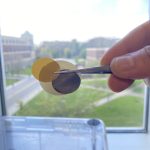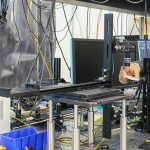Projects
Our projects span a number of interesting topics – from energy to biomaterials!

Hybrid Clay Films - From Antimicrobial To Energy Applications
An effective approach to deal with the environmental issues is to develop a sustainable, inexpensive, and environmentally friendly materials with broader applications. To that aim, we are working on clay-based materials for a wide range of high-value applications, including energy materials to antimicrobial applications.
US Dept. of Homeland Security
The layer-by-layer assembly of thin films have received growing interest in a variety of applications worldwide. Methods for depositing films, patterning, unconventional assemblies and approaches are gaining popularity. Interestingly, several naturally occurring clay minerals have layered structure with possibility of interchangeable intercalated ions and tuneable chemical properties

Polymer-Based Foams For Hemostasis And Wound Healing
There is an immediate need of developing appropriate economically viable FDA-approved hemostatic treatments that can effectively stanch blood loss. We are developing a rapid action polymer-based hemostatic bandage system that is capable of withstanding uncompromising blood-loss. The objective is to stagnate bleeding and promote wound healing in a manner superior to those currently available.
Hemorrhage remains the main cause of preventable death on the battlefield. This underscores the need of developing appropriate hemostatic treatments that can effectively stanch blood loss while remaining easily applicable at the point of care. Traditional methods such as gauzes and tourniquets have gained inadequate success, and as such the fabrication of novel hemostatic materials has advanced tremendously in the last decade. Although there has been considerable success in recent years in engineering novel hemostats, developing an effective hemostatic material that is biocompatible, fast-acting with hassle-free application and removal, yet being a cost-effective viable option remains a challenge. In this project, we have developed a self-conforming, rapid action siloxane-based hemostatic bandage system that is capable of treating large amounts of blood loss. The objective is to provide the patient with a means to rapidly arrest bleeding from trauma-related wounds in a manner superior to those currently available, within few minutes.

Designing Transparent And Durable Polymeric Coatings For Dust Mitigation
The extreme environments encountered in space necessitate strict EVA protocols to protect against thermal, radiation, MMOD, atomic oxygen, extreme pressures in inert and oxidizing or caustic atmospheres. Addressing this issue, in this project we are developing a dust-repellent coating system that can resist the attachment of a wide range of solids, while at the same time, resist the wetting of both high and low surface tension liquids.
Air-borne particulates, dusts, and powders from debris can penetrate, accumulate, and transport through both porous and non-porous surfaces and are serious surface operational and bodily threats to space planetary explorers. Additionally, these risks also affect the crew equipment for crew members such as rovers, space vehicles, and on-board instruments, sensors and electronic panels therein. We are developing coatings that will utilize low surface energy functional polymers that are either directly, covalently attached on to the underlying substrate, or are embedded within a durable elastomer. Such coatings can prevent the attachment of regolith, high fidelity simulants, lunar dust on surfaces by utilizing interfacial slippage

Module For Rapid Detection Of Gases From Fire And Smoke
This project aims to develop a novel photonic integration on chip for a reduced cost and
deliver higher performance to rapidly detect gases and aerosols with almost no interference or
fingerprints from other gases through chemical activity. The emitter array will generate narrow,
high intensity, steerable beams, while the detector array allows for a fast, coherent detection of
terahertz (THz) waves.
US Dept. of Homeland Security FEMA
The National Interagency Fire Center (NIFC) recently reported more than 3 million acres have burned every year since 1999, and the acreage burned each year is increasing from more than 60,000 wildfires occurring in the United States each year.
Our hand-held module will be easy to carry or maneuver using drones, robotic arms, retro-fit to aerial, sea, or land vehicles to detect toxic gases, aerosols and organics, thereby protecting lives and health of the firefighters and victims during fires or explosions. Compared to other approaches and detections methods that are bulky, expensive to maintain, space-constrained, inlab units only and costly, our device can be carried by crews and civilians for services at a fraction of cost. We will work with firefighters and associations to train the crew on usability of such device.